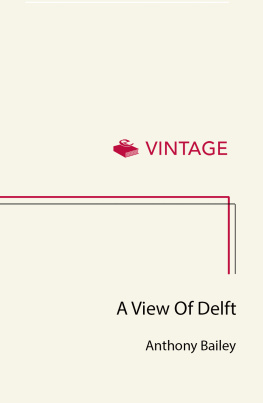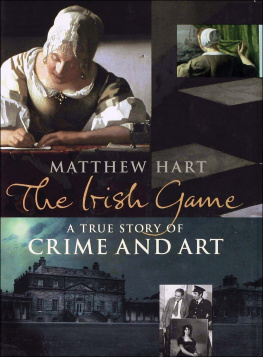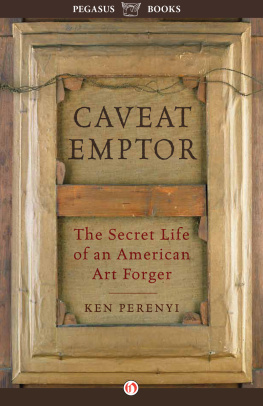I WAS VERMEER
The Rise and Fall of the
Twentieth Centurys
Greatest Forger
Frank Wynne

CONTENTS
For my mother, for her love and her
unfailing, often bemused, support.
To the memory of Ric Shepheard: filmmaker,
fraudster, friend, for his brilliance and inspiration.
La vie tant ce quelle est, on rve de vengeance.
Paul Gauguin
The best way to learn about fakes
is to get in touch with a forger.
Thomas Hoving, False Impressions:
The Hunt for Big-Time Art Fakes
I am sitting in Het Molenpad, one of the oldest and most gezellig of Amsterdams brown cafs. The few tables on the pavement overlook the sweeping curve of the Prinsengracht, all the more beautiful on this early summer morning as dappled green sunlight spills through the leaves on to the still waters of the canal. I sip my beer and wait to meet my first convicted forger.
Forgery is a booming industry though not perhaps one a career-guidance counsellor will recommend to your gifted child. The former director of the Metropolitan Museum of Art, Thomas Hoving, estimates that 60 per cent of all the works offered to him during his sixteen-year tenure were not what they appeared to be; the New York Times has suggested that 40 per cent of all major works offered for sale are forgeries. This is not a recent development: as long ago as 1940, Newsweek alleged that of the 2,500 authentic works painted by Jean-Baptiste Camille Corot, 7,800 are in American collections alone.
Forgery is arts shadow-self, the vice without which virtue is impossible. For as long as mankind has coveted objects for their history, their beauty, their proximity to genius, the forger has been there with a mocking smirk ready to satisfy the demand. Art is the business of selling fetishes, sacred relics once touched by genius: what the forger offers the gullible buyer is not art, it is authenticity, something John Groom argues is the abiding perversion of our times. It is indulged as a vice, worshipped as a fetish, embraced as a virtue. [...] Everything it touches turns to gold or at least is burnished with a scrape of lustre and in that sense it is the mark of genius, the Midas touch, the apotheosis of capitalism.
For an artist with a little talent and few scruples, forgery offers not only riches, but a clandestine celebrity. To know that ones paintings hang in the Louvre, the Met, the Tate even if no one else can ever know is the finest revenge. Once in a gallery, there is little chance that the forger will be unmasked: as Thodore Rousseau pointed out, We should all realise that we can only talk about the bad forgeries, the ones that have been detected; the good ones are still hanging on the walls.
Forgery, said Orson Welles, is as old as the Eden tree. By the time the ancient Greeks arrived to begin the looting of Egypt which would continue for two thousand years, Phoenician and Sumerian forgers skilled in the making of ancient Egyptian artefacts were waiting for them. In Rome, when Caesar Augustus commanded Virgil to create an epic to rival those of Homer and the empire struggled to forge for itself a history that might rival the Greeks, the statues of the greatest of Greek sculptors of the fourth and fifth centuries BC Phidias, Praxiteles and Lysippus changed hands for exorbitant sums. But the statues which graced the homes and private temples of senators and wealthy merchants were forgeries carved in sweatshops outside Rome. Pasiteles, one of the most gifted forgers of his generation, even wrote a sensational expos of his forgeries. The manuscript, sadly, has been lost, but the myth of its existence may one day tempt a skilled forger to invent it.
In Renaissance Italy, at the height of perhaps the greatest flowering of human endeavour, the young Michelangelo, in an attempt to impress his patron Lorenzo de Medici, forged Roman sculptures and buried them in the gardens of the Medici palace, later arranging for these ancient artefacts to be discovered. According to Vasari in his Lives of the Artists
He also copied drawings done by various old masters so closely that they were not recognised as copies, for by staining and ageing them with smoke and various materials, he soiled them so that they seemed old and could not be distinguished from the originals...
Michelangelo would borrow works of art in order to copy them, but he returned the copies, keeping the originals for himself.
Forgery can lay claim to being the second-oldest profession, and so it seems somehow appropriate to be waiting for a forger here in the stilly, greeny summer of Amsterdams genteel western canal belt, barely half a mile from where lissom women in picture windows practise the oldest profession: both, after all, know something about faking it.
Geert Jan Jansen arrives, a short, stocky man with a shock of white hair pushed back from his balding pate. In my finest Dutch I order two beers, and the barman inevitably answers in perfect English. The casual incredulity the Dutch reserve for those of us foolish enough to try to learn their language is matched only by their conviction that we have no hope of mastering it.
Soft-spoken and gracious, Geert Jan Jansen makes an improbable master criminal, and yet he admits to having forged thousands of paintings, drawings and watercolours by a Picasso, Matisse, Dufy, Mir, Jean Cocteau and Karel Appel. I look down, but the only question I have pencilled on my notepad is why?.
The why of forgery is thornier than the how. To art critics, the forger is a mediocre artist seeking revenge; to the media, a conman interested only in money; to the apologist, he is the equal of the masters he has forged; to the public he is often a folk hero. Where the common thief or the mugger is despised, it is difficult not to admire the forger, not to feel a surge of joy at the thought of a critic waxing lyrical over the glories of a seventeenth-century masterpiece on which the paint has barely dried. Even when forgeries are badly done, they highlight the capacious self-delusion that must have been necessary for anyone to be fooled, writes Cullen Murphy; When they are superb, they represent a triumph of the human spirit.
For Geert Jan Jansen, the why was simple. Having studied art history, he worked for the fashionable Amsterdam gallery Mokum. Later, he set up his own galleries, Jacob and Raam. His fellow-dealers were fulsome in their praise of his impressive feeling for art. But when I was running my galleries, my best customers were the bailiffs I couldnt make enough money to survive and I didnt want to lose the shop. Jansen began modestly, transforming humble posters with a pencilled number and the simple flourish of the artists signature and selling them as limited-edition lithographs. With the proceeds, he could fill his gallery with the paintings he truly admired. It was only a matter of time before he was tempted to go beyond forging signatures, to faking the paintings themselves.
My first forgery was a Karel Appel. I sold it to a famous Dutch architect and later I heard him boast to another dealer that hed seen the painting on an easel in Appels studio. I thought: if everything goes this easily... His second forgery, also an Appel, he offered to a London gallery. Since he had scant documentation for the work, the auction house decided to verify the painting before sale and sent a photograph to Appel himself, who stated categorically that it was genuine. Child with Toy set a record price for a work by the artist.
I took no pleasure in the deception itself. Personally, Im against forgery...
I splutter nervously, but his face is deadly serious. Then, I see a shard of a smile, an emotional leak, a manifestation of what psychologist Paul Ekman calls duping delight: the pleasure of lying for its own sake.









